The transparency era is here
A communications playbook to take control of your workplace equity story
This playbook is for you
This playbook is for leaders across the company and around the world facing the pressures of increased transparency around workplace equity.
It's for companies that are already (or soon will be) required by law to post salary ranges or report on pay data; for companies fielding intensifying questions from employees about pay; and for forward-thinking leaders who see the opportunity to harness transparency for a competitive edge but need the right tools to proceed.
No matter where you're starting from, this playbook offers the strategic advice, real-world examples, and hands-on guidance you need to move forward in an intentional, comprehensive way. It will help your organization identify where you are and where you aspire to land on your transparency journey. And it will help you navigate the current environment of transparency, while also looking around corners to prepare for what's coming — because more is coming.
Remember: Every small step towards more transparency is a giant step towards more trust.
Want to download this Communications Playbook as a PDF?
01 The transparency era is here
Maria Colacurcio
Chief Executive Officer
Syndio
It was only a short time ago, in January 2021, that Colorado enacted the first law requiring that pay ranges be included in job postings. And less than five years since California enacted the first law requiring ranges be provided upon request. Fast forward to today, and the pay transparency era has arrived in full force.
With pressure to be more transparent coming from every angle, leaders are grappling with a fundamental question: How transparent do we want to be? I come to this discussion as both a leader navigating this journey for my own company and from the vantage point of my front-row seat to the pay transparency movement as the CEO of Syndio, a workplace equity analytics platform.
Laws in Colorado, New York City, and revised laws in California and many other jurisdictions have forced companies to include salary ranges in job postings, but that's just the beginning. More laws are coming, including requirements expected in 2024 across the European Union. Pay reporting laws are also sweeping the world. And now that ranges — and in some cases reports — are public, they've triggered an onslaught of questions from employees that companies are largely unprepared to answer.
Sunlight disinfects disparities. Once you shine a light on how you compensate employees, you must explain why. At Syndio, we call this "pay explainability." The ability to clearly convey how your organization determines pay, how you apply it to individual employees, and whether pay is equitable and consistent is the underpinning of a successful transparency strategy.
Today, the choice is not to be transparent or not, but how far to go. In this guide, we give you a glimpse into what's coming and help you make sense of your options so you can take control of your story, build trust, and seize that first-mover advantage in the form of higher retention and employee devotion. I see the trust that transparency has helped us build within Syndio and I see it with the leading organizations Syndio supports. Let's go!"
02 Why companies are embracing the transparency era
Complying with transparency laws is the bare minimum. But beyond that, leaders have a choice about how much they want to communicate. Companies including Salesforce, Starbucks, Microsoft, Visa, and many others are part of a growing wave of employers disclosing more than what's required by law.
By being proactive about sharing information, they control their story. They also shine a spotlight on the good work they're doing and acknowledge the work still to be done before employees, investors, or others shine a (potentially unfavorable) light for them. Take note — what a couple of these trailblazers are doing today points to what's coming tomorrow.
Median pay gap
Measure of overall differences in median earnings between two populations by comparing the earnings of the middle employee for one group to the middle earner in another group.
Pay equity
Compensating people performing substantially similar work in a way that is not based on gender, race, or other protected categories.
Opportunity equity
All employees have equal access to opportunities for employment, advancement, and development, regardless of gender, race,
or ethnicity.
Workplace equity
Workplace equity requires both pay equity and opportunity equity. All employees are treated equitably and without bias at each stage of the employee experience.
A trend to watch: Leaders disclose median pay gap
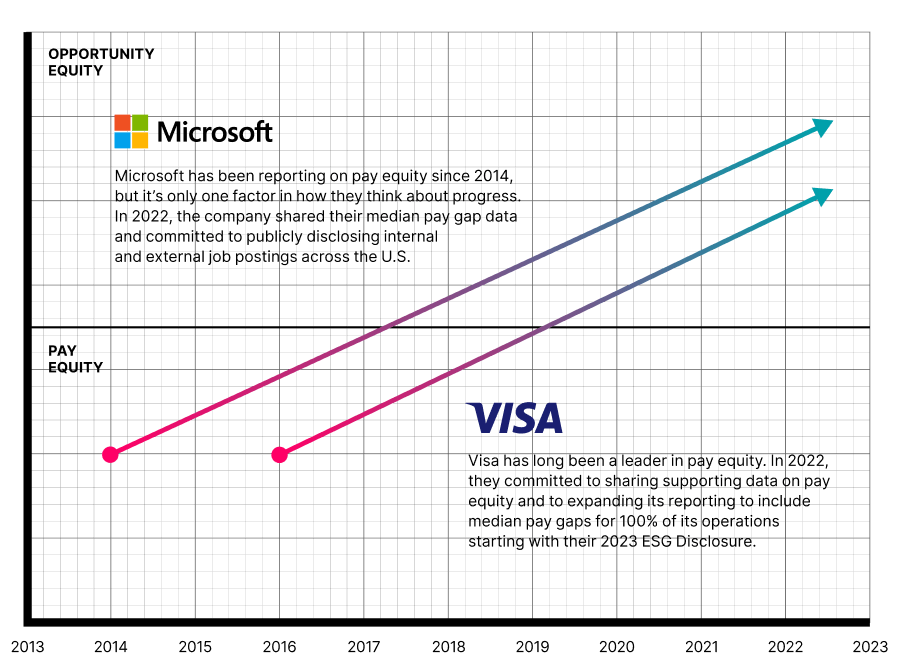
Other leading companies disclosing or agreeing to disclose their median pay gap include Adobe, American Express, BNY Mellon, Chipotle, Citi, Disney, The Home Depot, Mastercard, Pfizer, Starbucks, and Target, to name a few.
5 reasons C-suite executive and HR leaders are embracing transparency
Transparency creates built-in accountability. We hear disclosing and regularly revisiting data and commitments builds accountability into your workplace equity strategy. It's a virtuous cycle: accountability drives action and progress.
Candor builds trust...
Especially if you share some challenges. Developing a consistent transparency cadence gives you the chance to share incremental progress so you can continuously earn trust from employees, candidates, investors, and the public. Nearly 70% of employees said that they would take one job offer over another based on the organization's transparency practices.
Transparency helps retain employees.
While Buffer's approach to transparency is an extreme example of pay transparency, their employees feel so respected by their employer that their retention rate is 94%. Syndio has also maintained a 90% retention rate by embracing transparency as we've scaled. In addition to posting salary ranges before any laws went into effect, we are transparent about pay and opportunity gaps.
Transparency validates your commitments and strengthens your business.
Syndio's 2023 Workplace Equity Trends Report found that companies that are more transparent are 3x as likely to strongly agree that they build diverse teams and develop talent. What's more: We are seeing business performance improvements among companies that voluntarily and publicly disclose more data on the workforce in EEO-1 forms. A new analysis "strengthens and confirms previous research as it finds a positive association between diverse representation in management and positive financial performance." And, as more companies become transparent about their workplace equity, laggards may find it increasingly difficult to explain to their people or boards their refusal to move with the market.
Starting to communicate now mitigates future risk.
By getting proactive about what you share and starting to own your story now, you mitigate a growing list of looming risks, including proxy votes around pay equity and increased scrutiny around ESG.
Help for the naysayers and worriers: how to handle common objections
What happens if leadership (or your legal team) is concerned about making too much noise? Here are some objections you might hear — and how to handle them.
Will transparency spark a lawsuit?
Employers who are more transparent may actually be less likely to be sued. As Seher Khawaja, Senior Attorney for Economic Empowerment at Legal Momentum (formerly NOW Legal Defense and Education Fund), put it: "Litigation is costly for everyone involved. One of the driving motivations behind our push for pay transparency is to reduce and ideally eliminate the need for employees to bring pay equity litigation by creating the conditions and incentives to drive employers to set pay more equitably and to hold themselves accountable. The shift towards more transparent models will inevitably unearth problematic disparities; and we recognize employers will need some time to clean house and correct them."
Do I have to choose between transparency and privilege? Does this mean I'm waiving the attorney-client privilege?
No, it's not an "either/or." Companies often conduct privileged workplace equity analyses. (In fact, the majority of Syndio customers conduct privileged analyses.) Many of these companies are also open about the conclusions of their workplace equity analyses. Transparency and the attorney-client privilege are not necessarily totally at odds. As the court in Cahill v. Nike put it, "the disclosure of the outcome of the process does not constitute a waiver" of the attorney-client privilege. It's a careful balance and one you want to approach with legal advice, but don't assume that you cannot be transparent if you conduct privileged analyses.
Will this cause OFCCP to audit the site, or gain access to our privileged analyses?
For employers that do work with the federal government in the U.S., there is often fear that being transparent could prompt an audit by the Office of Federal Contract Compliance Programs (OFCCP), or require disclosure of workplace equity analyses. The good news is that the OFCCP must follow neutral selection criteria and being transparent is not one of the criteria OFCCP uses to select employers for audit. Also, OFCCP's Revised Directive means employers can conduct privileged pay analysis — and prove it to OFCCP without waiving privilege.
What is the risk of laying low and saying nothing? That's risky, too. Nature abhors a vacuum. When there's silence, employees will fill the void, often with misinformation.
03 Understanding the transparency spectrum
When people think about pay transparency, they think about posting salary ranges. But that's only one piece of the transparency spectrum. The complete spectrum includes pay range transparency, pay equity transparency, and opportunity transparency.
Transparency levels
Within each category, there is a range of how transparent you can be: from less to more, as depicted below.
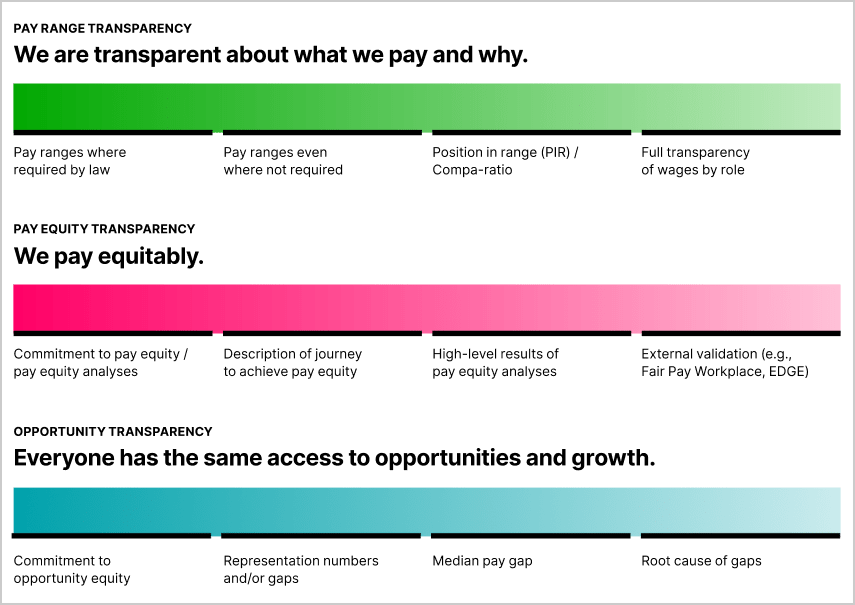
04 Transparency requires pay explainability
Complying with the new era of transparency is not the same as successfully tackling the pay explainability that comes with it. When you post ranges, you need to be ready to answer employee questions about why they're paid what they're paid. This is where companies struggle, as they're still relying on decades-old compensation and leveling structures that were meant for compensation management, not communication.
Reexamining your compensation philosophy will enable you to confidently deliver a higher level of pay explainability moving forward — because questions employees are asking about pay ranges now will naturally lead to questions about pay equity and opportunity equity.
Pay explainability
The ability to clearly convey your compensation philosophy (how pay is determined overall) and how that applies to individual employees, as well as whether or not pay is equitable and consistent.
Your top priority: Pay explainability
Getting proactive about pay explainability builds critical trust with employees and lays the foundation for your workplace equity journey.
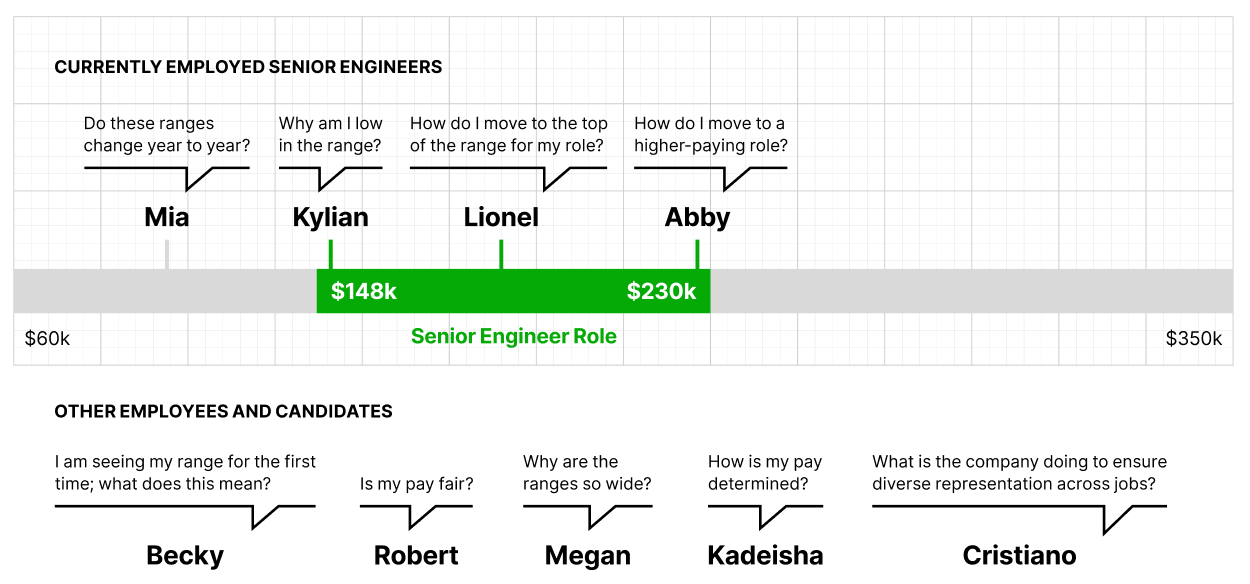
Prepare your people managers
At a time when employers are sharing more, how you prepare your people managers dictates how successful you are with your transparency initiatives. Yet, helping managers communicate about pay is getting more complicated. Instead of trying to turn managers into compensation experts, companies are using centralized communication tools like video vignettes to explain pay to both managers and their employees.
The best HR teams offer managers a clear, concise breakdown of their organization's compensation philosophy (e.g., job you're in, skills you have, time in role). Armed with that information, managers can explain where an individual employee fits within a range, what's needed to move up, and how differences in pay are the direct result of their company's compensation philosophy.
According to Gartner®, "Employees' perceptions about their pay are not encouraging — only 32% believe their pay is fair, 34% believe it's equitable and only 40% believe that pay procedures and practices are applied consistently. The lack of transparency about pay and how equity is assessed exacerbates employees' perception that pay is unfair."
Gartner
EPIC: 3 Ways to Drive Better Pay Equity Decisions, Christie Struckman, Debra Logan, Tony Guadagni, 10 October 2022. GARTNER is a registered trademark and service mark of Gartner, Inc. and/or its affiliates in the U.S. and internationally and is used herein with permission. All rights reserved.
05 Build your transparency roadmap
An effective transparency strategy is one based on incremental, intentional, and consistent communication. Use the framework below to determine what the right roadmap looks like for your organization.
Once you've made decisions about what you want to share, plot the steps you need to take over a multi-year period. There's no single timeline or process. Every company has specific requirements that will define their best path forward. Here's one example to get you started.
Example roadmap: Pay equity transparency
Below is an example roadmap that zooms in on pay equity transparency. Visit the Syndio blog for additional examples, including roadmaps focused on pay range transparency, opportunity transparency, and workplace equity reporting.
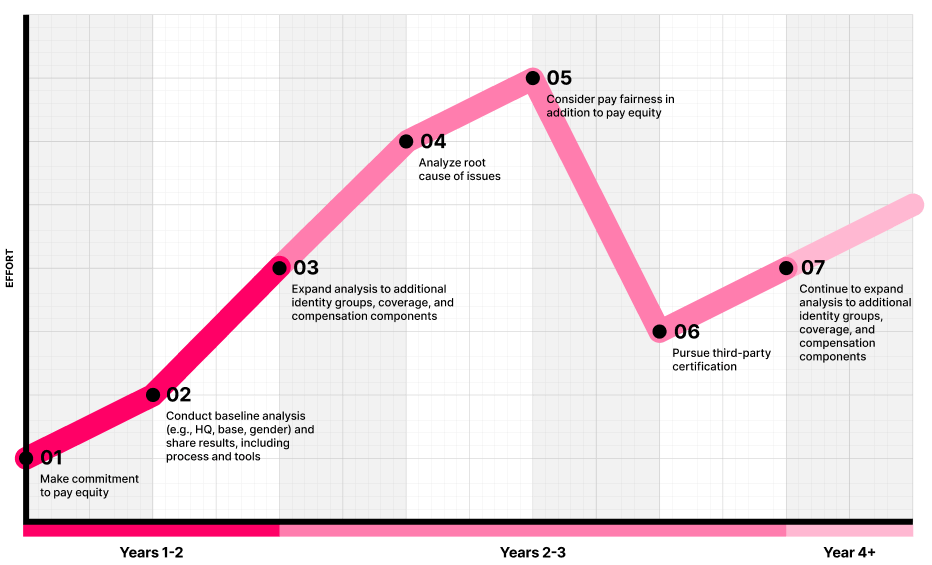
As your transparency strategy matures, there are several ways to use third-party technology providers and certification organizations to help craft the narrative and lend legitimacy and credibility to your workplace equity message.
Build your story using data visualizations
Sharing data visualizations with the core team working on the results and to leadership lends both clarity and credibility to a conversation that, for many people, is still new. Data visualizations like below often serve as a backbone for the narrative framework that of "how we got here" and provide opportunities for improvement at the root cause for future commitments.
Actual vs. Predicted Compensation
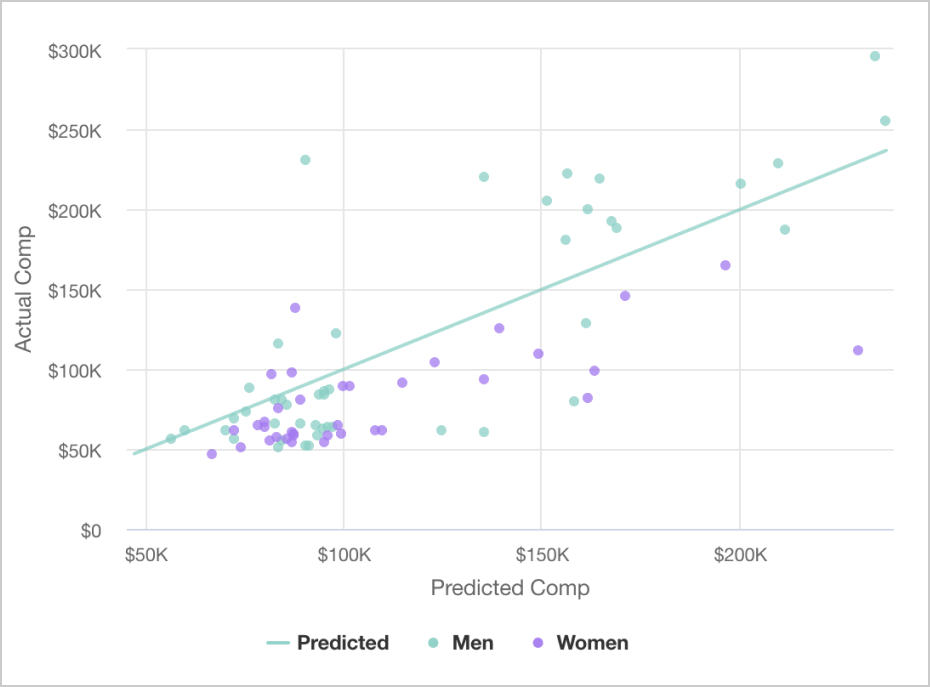
Impact of Pay Policies
For this employer, each Geo Zone was intended to be 10% more than the next. Analysis of pay practices identified that in their Sales Operations group, Geo Zone 3 is paid 10.19% more than Geo Zone 2, in line with expectations. However, Geo Zone 4 is paid only 11.19% more than Geo Zone 2, suggesting that the employer is not differentiating by Geo Zone as intended, which may be causing the pay inequities in this group.
Build credibility with certification
Some companies pursue certification from organizations like Fair Pay Workplace and EDGE, undergoing a rigorous pay equity evaluation and committing to ongoing analysis. Certified companies, including those listed below, can then use certification as a valuable proof point to boost their brand and employee retention and hiring.
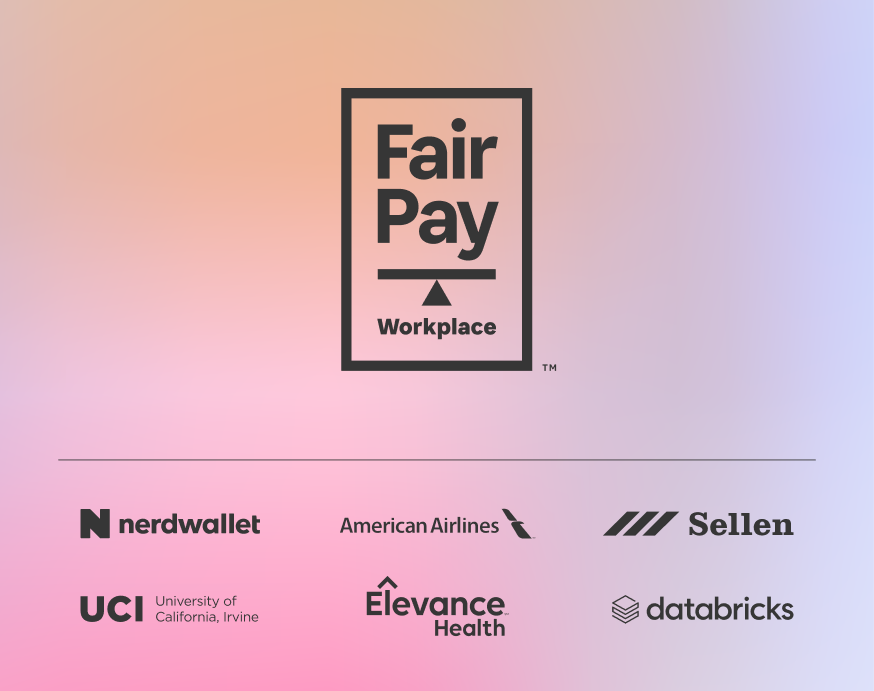
Make transparency your next move
The transparency era is here and leaders are rising to the challenge — adopting new tools and technology to analyze workplace data, digging deep into pay explainability, and refining their compensation philosophy. They're also working across HR, Legal, Communications, and Leadership to tell a consistent, clear, and compelling workplace equity story vital to their employer brand.
This takes work. But if you do it well, there's a big payoff that comes from reducing risk and building accountability and trust with your people.
There's urgency to embrace transparency, but you don't have to go "all-in" all at once. (In fact, please don't!) Just like workplace equity, transparency is a journey — where you take one step at a time and build as you go.
If you have questions and could use some experts in your corner, contact the Syndio team. We're here to help.